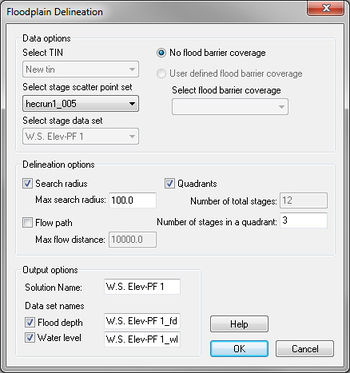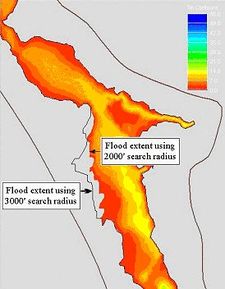WMS:Delineate Floodplain
There are several options that must be defined in the Floodplain Delineation dialog shown in order to delineate a floodplain in WMS. Each of these options are explained and described in detail below.
Select a TIN
When working with a single TIN this option will be dimmed out. However, it is possible to have more than one TIN in WMS. In such cases, specify the TIN on which the floodplain delineation will be performed.
Select the Stage Scatter and Dataset
Water surface elevation data used to derive the floodplain are imported and processed in WMS as scatter datasets. In addition to the scatter set (the xy locations of water surface elevation points), a particular dataset must also be specified. It is possible to have a single scatter set (locations of water elevations) with multiple datasets representing the water levels themselves. This will often occur when multiple scenarios of a hydraulic model are run. See the information on preparing stage files for more information about creating scatter datasets for floodplain delineation.
Select a Flood Barrier Coverage
A flood barrier coverage allows incorporating flood barriers representing natural or artificial barriers that are not represented explicitly by elevations in a TIN. The floodplain delineation process considers these barriers during water level interpolation. The resulting flood depth become closer to reality rather than a mere interpolation. For example, an embankment or a road is not always represented in a TIN.
In order to delineate the floodplain properly, these barriers must be considered in a hydraulic model as well as in floodplain delineation process. This option not only incorporates such existing barriers in the process, it also provides the flexibility to professionals so that they can consider proposed structures and evaluate the “what if” scenarios.
Maximum Search Radius
Water surface elevations are determined for each TIN vertex by using interpolation from a set of "nearest" water surface elevations in the stage scattered dataset. The maximum search radius defines the limiting distance that will be used when collecting the nearest stage scatter points. If the Use Flow Paths option is turned on then the "radius" distance is the flow distance path, whereas if the option is turned off it is the straight line (as the crow flies) distance.
The floodplain delineation process offers several options for selecting water levels that are used in the interpolation. As expected, these options and the values of the parameters used in the process affect the resulting floodplain delineation. Therefore, care must be taken in selecting these options and appropriate values.
The effect of search radius and flow distance are demonstrated in the figure shown below. The figure shows the flooded areas delineated using a 2,000 foot search radius and flow distance in the shades of colors. The line represents the extent of flooding delineated using a 3,000 foot search radius and flow distance. For most places along the river these two flood extents coincide except in the west side of the middle portion. In that area a 3,000 foot search radius and flow distance resulted in more flooding than the 2,000 foot search radius and flow distance. This indicates the earlier the process could not compute flooding in that area because of the 2,000 foot limit. The water levels that could flood that area were discarded because they were outside of the 2,000 foot search radius or flow distance. To avoid this kind of problem, floodplains should be delineated by increasing the search radius and the flow distance until the flood extents stop changing. The final extent would then be the extent determined by the topography not by the search radius and flow distance.
Using Flow Paths
The flow path option in the floodplain delineation process ensures that the sources of water, i.e. the water levels, and the areas flooded (TIN vertices for which water surface elevation is interpolated) are hydraulically connected. This is an important option because if not applied, the process may interpolate water levels while ignoring obstructions between the water levels and the point of interpolation.
Quadrants
The quadrant option ensures the water levels are selected for interpolation from different directions instead of being biased by a particular direction. When using this option water elevations used for interpolation are selected equally from the four primary quadrants surround the point of interpolation. If no water levels, or an insufficient number, are found in a quadrant the process proceeds using that many fewer water levels for interpolation.
Number of Stages
A number of stages used for interpolation must be defined. If the quadrant option is turned on, it's necessary to specify the number of closest stage points to find within each quadrant. Without the quadrant option then the total number of nearest stages are specified. It is not required that the number specified be found, interpolation will proceed as long as one possible water elevation scatter point is found to meet the specified criteria. For example if 2 stages from each quadrant is specified, and one quadrant has zero possible choices and another quadrant only 1, then 5 points will be used in interpolation.
Resulting Datasets
The floodplain delineation tool generates two different types of datasets that can be used for contouring and further analysis with the TIN. First of all a dataset of water surface elevations at each TIN vertex contained in the floodplain is calculated and stored. Secondly TIN elevations are subtracted from the water surface elevations to create a flood depth dataset. Both, or either of the data sets can be specified for calculation. The data set(s) are TIN datasets and are managed by selecting the active dataset for the TIN.
Related Topics
WMS – Watershed Modeling System | ||
|---|---|---|
| Modules: | Terrain Data • Drainage • Map • Hydrologic Modeling • River • GIS • 2D Grid • 2D Scatter |  |
| Models: | CE-QUAL-W2 • GSSHA • HEC-1 • HEC-HMS • HEC-RAS • HSPF • MODRAT • NSS • OC Hydrograph • OC Rational • Rational • River Tools • Storm Drain • SMPDBK • SWMM • TR-20 • TR-55 | |
| Toolbars: | Modules • Macros • Units • Digitize • Static Tools • Dynamic Tools • Drawing • Get Data Tools | |
| Aquaveo | ||

